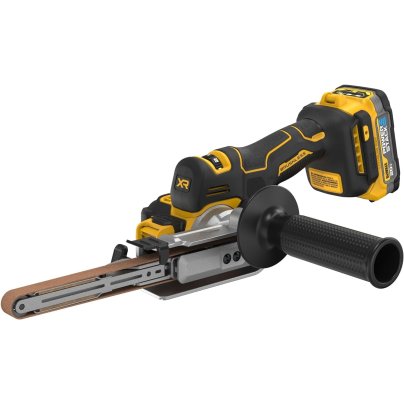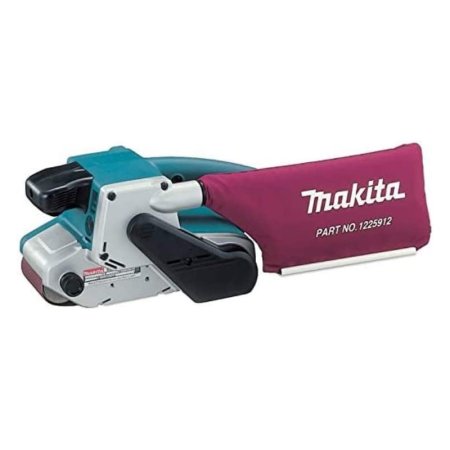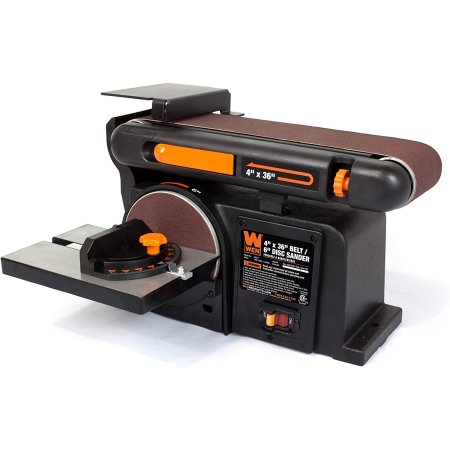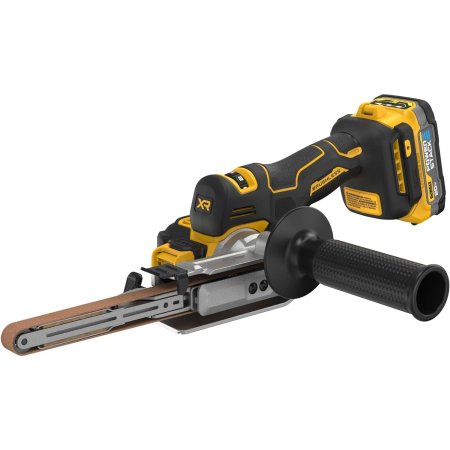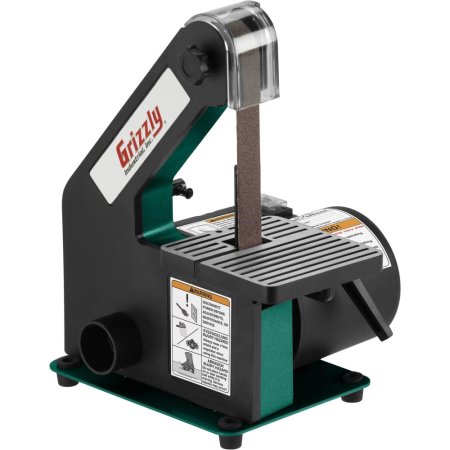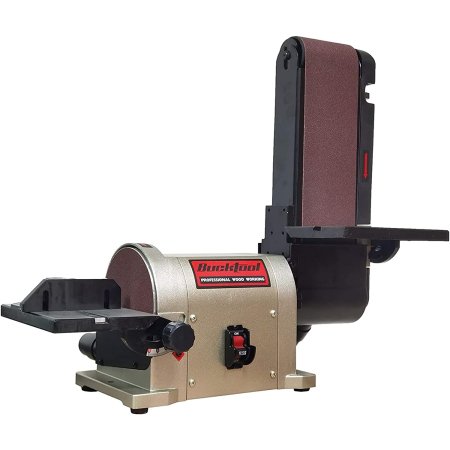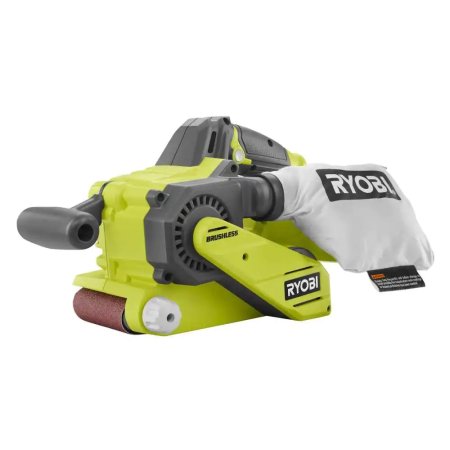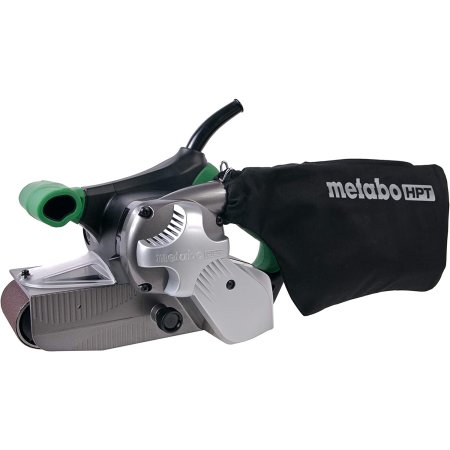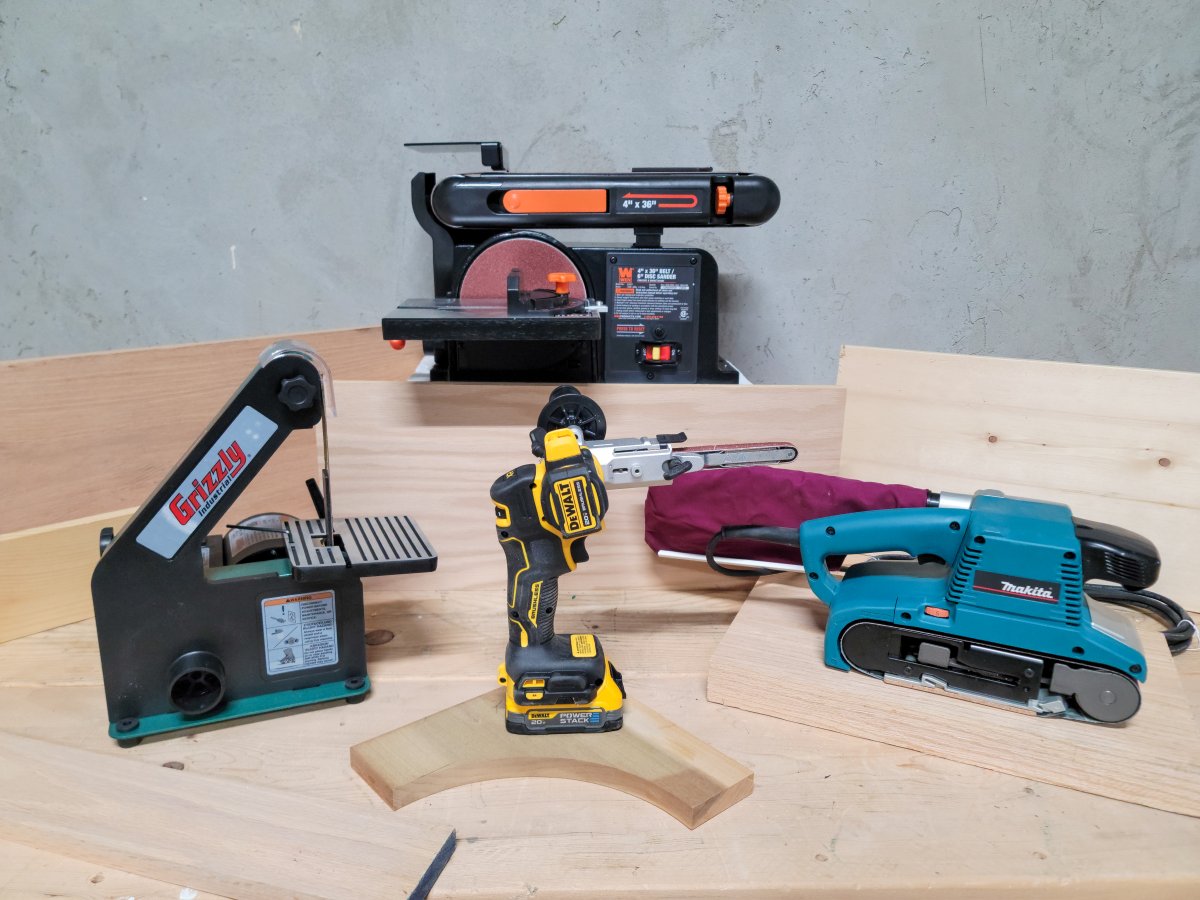
We may earn revenue from the products available on this page and participate in affiliate programs. Learn More ›
For anyone who works with wood, including carpenters, cabinet makers, wood floor refinishers, and DIYers, belt sanders are indispensable because they can quickly smooth rough wood surfaces. We researched more than a dozen models and selected the best of them for testing in our workshops. In doing so, we found a clear winner: the Makita 9903 3″ x 21″ belt sander, chosen because of its high-performance motor, auto-belt alignment, dust bag, and a max belt speed of 1,440 feet per minute (FPM).
Like all the best tools, a quality belt sander saves oodles of time, transforming a workpiece from rough to smooth and prepping it for finish sanding with a random orbital or detail sander. Ahead, learn what to look for when shopping for this power tool, and find out how the following models earned a spot on our list of the best belt sanders.
- BEST OVERALL: Makita 9903 3″ x 21″ Belt Sander
↓ Jump to Review - BEST BANG FOR THE BUCK: Wen 6502T Benchtop Belt and Disc Sander
↓ Jump to Review - BEST FOR DETAILS: DeWalt 20V Max XR 18” Bandfile Kit
↓ Jump to Review - BEST COMPACT: Grizzly H3140 1″ x 30″ Belt Sander
↓ Jump to Review - BEST BENCHTOP: Bucktool BS4603 Bench Belt & Disc Sander Combo
↓ Jump to Review - BEST CORDLESS: Ryobi 18V One+ 3”x 18” Brushless Belt Sander
↓ Jump to Review - BEST HANDHELD: Metabo HPT SB8V2 3″ x 21″ Variable Speed Belt Sander
↓ Jump to Review
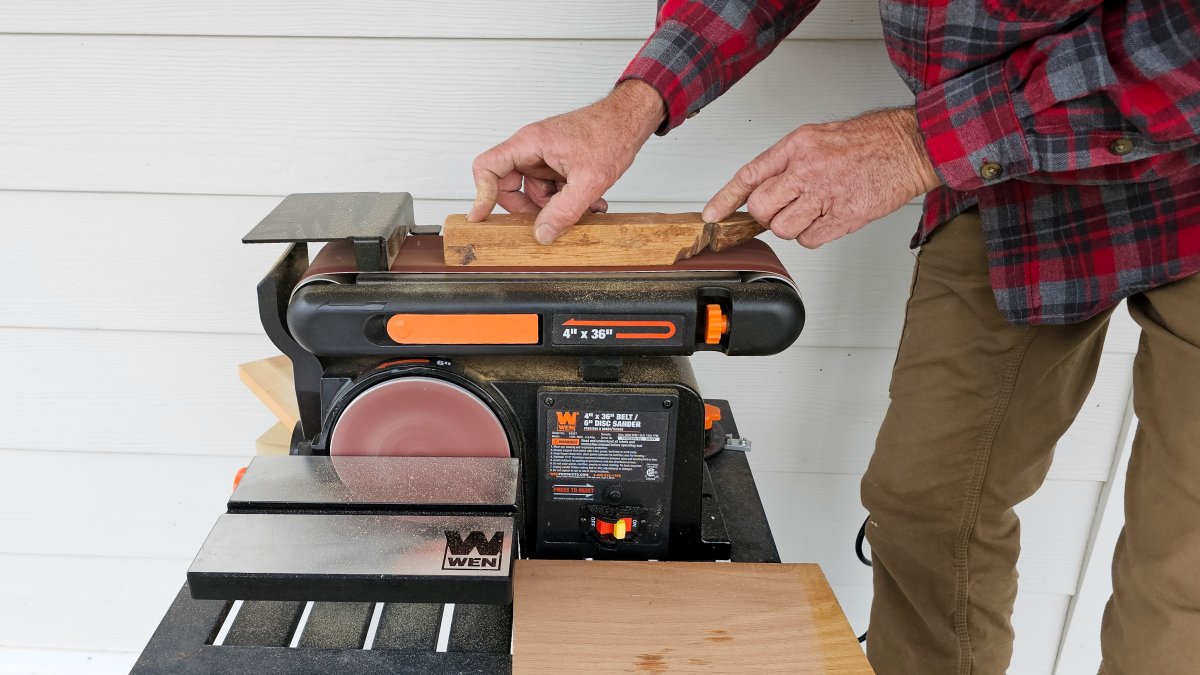
| Testing Stats | |
| Products tested | 4 |
| Time spent testing | 6 hours |
| Tests performed | 4 |
| Price range | $100 to $300 |
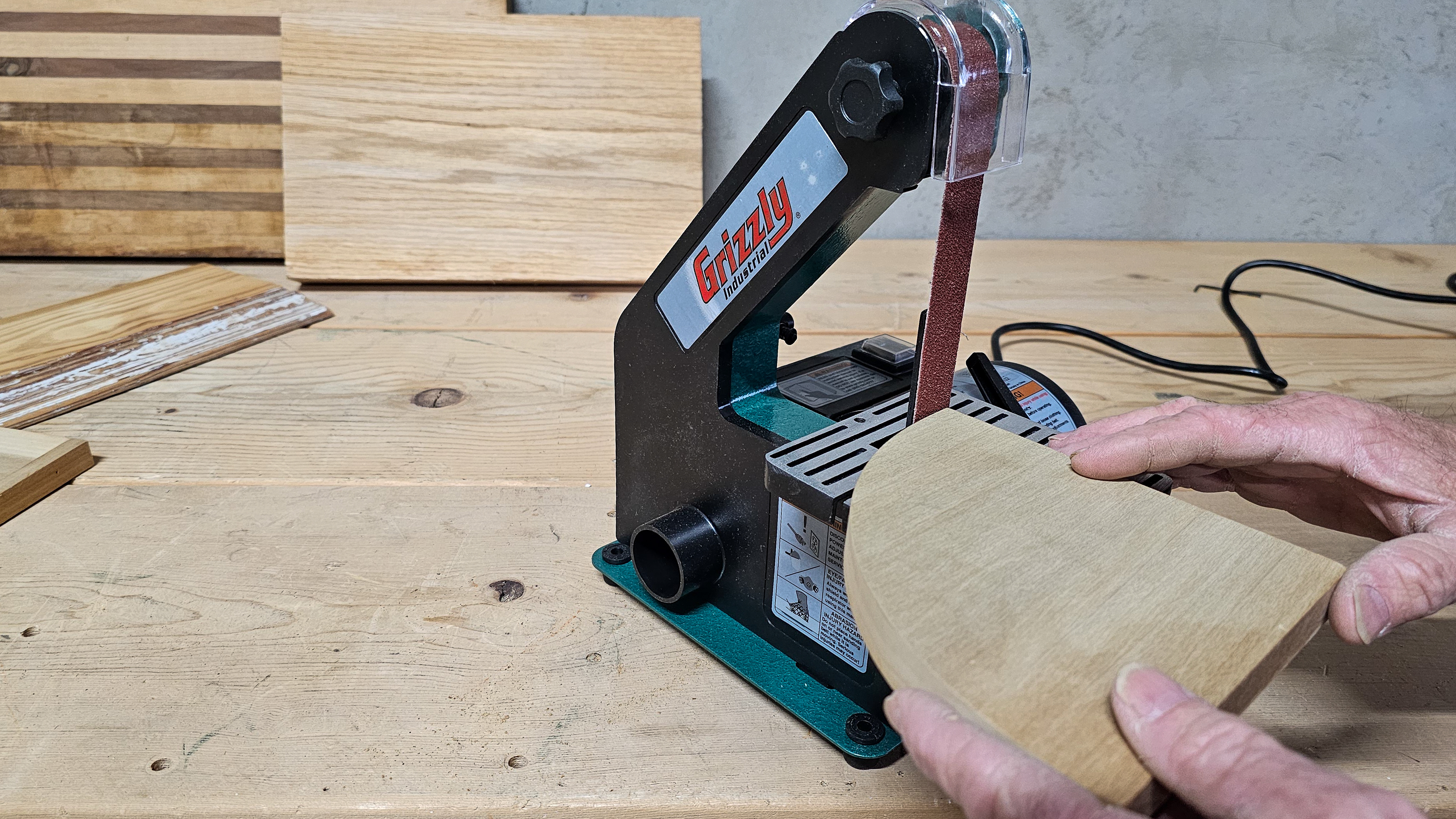
Our Top Picks
We tested top-rated belt sanders—both bench types and handhelds—to find the best options for different types of woodworking projects. Here, we list the pros and cons and highlight the projects where each sander performs best. and the product specs detailed above to find the best belt sanders for your next project.
Best Overall
Makita 9903 3" x 21" Belt Sander
What We Like
- Powerful 8.8-amp performance
- Includes dust collection bag
- Auto-tracking to keep the belt centered
- Variable speed setting
What We Don’t Like
- Not cordless; reduced portability
Product Specs
- Speed: Variable speed from 690 to 1,440 FPM
- Power: 8.8 amps
- Belt size: 3 inches by 21 inches
Our Ratings: Ease of Use 5/5; Performance 5/5; Dust Collection 4.5/5; Value 4.8/5
The Makita 9903 belt sander is a beast! This traditional belt sander can be used to remove the old stain and finish from hardwood flooring and smooth rough wood surfaces before applying the finishing touches. We tested this wide belt sander on different types of wood, and it quickly removed roughness from both hardwood and softwood. However, we had to take care when testing on softwood (cedar) to prevent removing too much material at once.
We liked the auto-tracking belt alignment feature, which kept the abrasive belt centered on the track even after several sanding passes caused the belt to heat up. We estimated the dust collection bag reduced the amount of airborne dust by about 65 percent, which we appreciated, but we’d still recommend wearing a dust mask when using this belt sander.
What our tester says: “If I could make one request, I’d ask Makita to make this model in a cordless version to increase its versatility. But, overall, this is a great belt sander and a timesaver for smoothing flat wood surfaces.”—Glenda Taylor, Product Reviews tester and writer
Get the Makita belt sander on Amazon, The Home Depot, or Walmart.
Best Bang For The Buck
Wen 6502T Benchtop Belt and Disc Sander
What We Like
- 2-in-1 sander
- Sturdy iron base
- Includes 80-grit sanding belt and disc
- Adjustable belt sander position; 0 to 90 degrees
What We Don’t Like
- Limited use due to benchtop design
Product Specs
- Speed: 3,600 RPM (disc)
- Power: 4.3 amps
- Belt size: 4 inches by 36 inches (belt), 6 inches (disc)
Our Ratings: Ease of Use 4.8/5; Performance 4.5/5; Dust Collection 4/5; Value 4.8/5
There’s a lot to like about the Wen 6502T bench-style belt sander—and best of all, it’s affordable. The belt feature allows it to be used as a horizontal or a vertical belt sander, which increases its versatility. It also comes with a 6-inch disc sander, which we used to sand smaller items.
We bolted the Wen sander to our workbench, although at 37.6 pounds, it’s beefy enough to stay put on its own for many sanding projects. We were able to easily adjust the belt arm flat or vertical, and the sander was sturdy and stable in both positions. We tested the Wen for sanding different types of wood, both hard and soft, and it made quick work of removing weathered surfacing and roughness from flat boards.
The 6-inch disc sander was great for end-grain sanding and shaping small pieces of wood. The saw’s cast aluminum table helped stabilize the workpiece, and its miter gauge was a boon for sanding precise end angles. It also features a dust port, but even when we connected our shop vacuum hose, it only reduced airborne dust by about 40 percent. Still, that’s helpful.
What our tester says: “I was pleased with the Wen’s quality construction and versatility. Even though it’s a budget sander, I feel it’s good enough to earn a spot alongside professional woodworking tools.”—Glenda Taylor, Product Reviews tester and writer
Get the Wen belt sander at Amazon, The Home Depot, or Wen.
Best For Details
DeWalt 20V Max XR 18” Bandfile Kit
What We Like
- Capable of sanding in tight spots with ease
- Adjustable sanding arm
- Precise speed control
- Comes with battery and charger
What We Don’t Like
- Not suitable for large, flat surfaces
Product Specs
- Speed: Up to 5,600 FPM
- Power: 20V cordless
- Belt Size: ½ inch by 18 inches
Our Ratings: Ease of Use 5/5; Performance 5/5; Dust Collection 4/5; Value 4.5/5
If you’ve done more than a handful of woodworking or construction projects, you’ve almost certainly had to get creative in order to sand hard-to-reach spots. We’ve wrapped sandpaper around small sticks and dowels to sand in those restricted spaces, but it’s clumsy at best and can take a long time to get good results.
DeWalt’s 20-volt bandfile belt sander offers a game-changing solution. We didn’t test this particular sander on flat boards; instead, we searched high and low to find small nooks and crannies on wood projects that we couldn’t reach with a traditional belt sander, and we were impressed!
The belt on this cordless sander is 18 inches long and just ½ inch wide, and the sanding arm is adjustable, so we were able to move it into the position that made it easiest to reach various test spots. We really liked the speed control aspect of this sander—it comes with a dial for general speed settings and a variable speed trigger for even more control.
It comes with a compact, 1.7 amp-hour (Ah) PowerStack battery and charger. PowerStack batteries are smaller but more powerful than standard batteries, and we found the 1.7Ah easily capable of running the sander. If you need more power, you can always swap in another DeWalt 20V Max battery.
Get the DeWalt belt sander at Amazon, Lowe’s, or The Home Depot.
Best Compact
Grizzly H3140 1" x 30" Belt Sander
What We Like
- Lightweight and compact
- Tilting support table
- Well-suited for light-duty sanding
What We Don’t Like
- Not suitable for heavy-duty sanding
Product Specs
- Speed: Up to 3,300 FPM
- Power: 2 amps
- Belt Size: 1 inch by 30 inches
Our Ratings: Ease of Use 4.8/5; Performance 4.5/5; Dust Collection 4/5; Value 4.8/5
This compact bench sander by Grizzly is well-suited for a small woodshop or even for a crafter or hobbyist. We mounted this sander to our workbench because it weighs just 10 pounds and had a tendency to slide during use when it wasn’t bolted down.
This is a light-duty belt sander, but we found it worked well for smoothing down rough grain on small items, such as dowels and 1-by-1 boards. It comes with a tilting table, which we were able to adjust when we wanted to sand angles and board-end miters.
This little Grizzly doesn’t offer a lot of fancy bells and whistles, but it does what it’s supposed to do: it sands small workpieces effectively. It could probably also be used as a belt sander for knife-making or to sharpen the edges of small blades, but we didn’t test it in that capacity.
We connected our shop vacuum hose to its dust port, but it didn’t make a measurable difference in the amount of airborne dust, so we’d recommend using this little belt sander outdoors or in conjunction with a separate dust extractor.
Get the Grizzly belt sander from The Home Depot or Grizzly Industrial.
More Great Options
We didn’t personally test the following belt sanders, but we selected them for inclusion in our lineup based on their build quality, features, power, and performance. If you’re still unsure about the right belt sander for your needs–odds are you’ll find it here.
Best Benchtop
Bucktool BS4603 Bench Belt & Disc Sander Combo
What We Like
- Adjustable belt arm
- Tilting aluminum work table
- Direct drive motor increases performance
What We Don’t Like
- Bench setup isn’t designed with portability in mind
Product Specs
- Speed: Up to 3,450 RPM
- Power: 5 amps
- Belt size: 4 inches by 36 inches (belt), 6 inches (disc)
Using a handheld belt sander for small projects or isolated parts is difficult because you need two hands to hold the belt sander, while the target object must be secured in a vise. Instead of rigging up that kind of system, consider opting for a benchtop model, like this one from Bucktool. The benchtop belt sander remains stationary while the user moves the target material to the rapidly moving sanding belt to sand, shape, or sharpen.
We like the design of this belt disc sander combo better than the Wen combo sander because the disc is located at the end of the machine, which makes it less likely to interfere with the use of the belt sander.
The direct-drive motor system improves sanding efficiency, while the heavy base prevents the sander from slipping or shifting during use. We also like the Bucktool sander’s adjustable belt arm and its aluminum work table that tilts up to 45 degrees for beveled sanding with the built-in disc sander. Just keep in mind that this stationary tool is not designed for portability.
Get the Bucktool belt sander at Amazon or Bucktool.
Best Cordless
Ryobi 18V One+ 3” x 18” Brushless Belt Sander
What We Like
- Suitable for remote use
- Includes 80-grit sandpaper belt
- Adjustable pommel handle
- On-off trigger with lock-on button
What We Don’t Like
- Limited power and speed
- Battery is not included
Product Specs
- Speed: 850 FPM
- Power: 18 volts
- Belt size: 3 inches by 18 inches
We’re big fans of the convenience that cordless tools offer. One of the most common problems in a crowded workshop is the constant tripping hazard created by corded power tools. While benchtop tools can be set up, plugged in, and positioned to limit this issue, handheld power tools need to be carried and moved around the workshop. That’s why we suggest investing in a cordless belt sander, like this one from Ryobi, to eliminate this safety hazard and increase versatility and control.
This Ryobi belt sander includes a 3-inch by 18-inch, 80-grit sanding belt and a dust collection bag. It also features an on-off trigger-lock switch and an adjustable pommel handle for better handling. However, this cordless model can only reach speeds of 850 FPM, so it’s a medium-duty sander. And it does not come with a battery or a charger, so users will need to purchase these accessories separately.
Get the Ryobi belt sander at The Home Depot.
Best Handheld
Metabo HPT SB8V2 3" x 21" Variable Speed Belt Sander
What We Like
- Powerful 9-amp motor
- Variable speed settings
- Built-in tracking window
- Dust collection bag
What We Don’t Like
- Limited range due to corded design
Product Specs
- Speed: Variable speed from 820 to 1,475 FPM
- Power: 9 amps
- Belt size: 3 inches by 21 inches
Benchtop belt sanders are great for smaller projects or to work on isolated pieces of a bigger project, but we prefer a handheld belt sander, like this Metabo HPT model, which is better for sanding a larger object that cannot reasonably be lifted into position for use with a benchtop sander. The Metabo HPT belt sander has a powerful 9-amp motor and a variable speed switch that allows the user to adjust the speed of the sanding belt from 820 to 1,475 FPM. That’s not as fast as some of the models we tested, but it will still sand down rough surfaces quickly and efficiently.
To improve control and visibility, the belt sander has a transparent tracking window that we think would be especially useful when sanding in a tight space, up against a wall, or in a corner where visibility is limited. The sander collects dust in a left-side-mounted dust collection bag to help keep the workspace clean and unobscured. However, despite these outstanding highlights, this model is a corded electric belt sander, which means that the power cord limits the range and portability.
Get the Metabo belt sander at Amazon, Lowe’s, or Metabo.
Jump to Our Top Picks
How We Chose and Tested the Best Belt Sanders
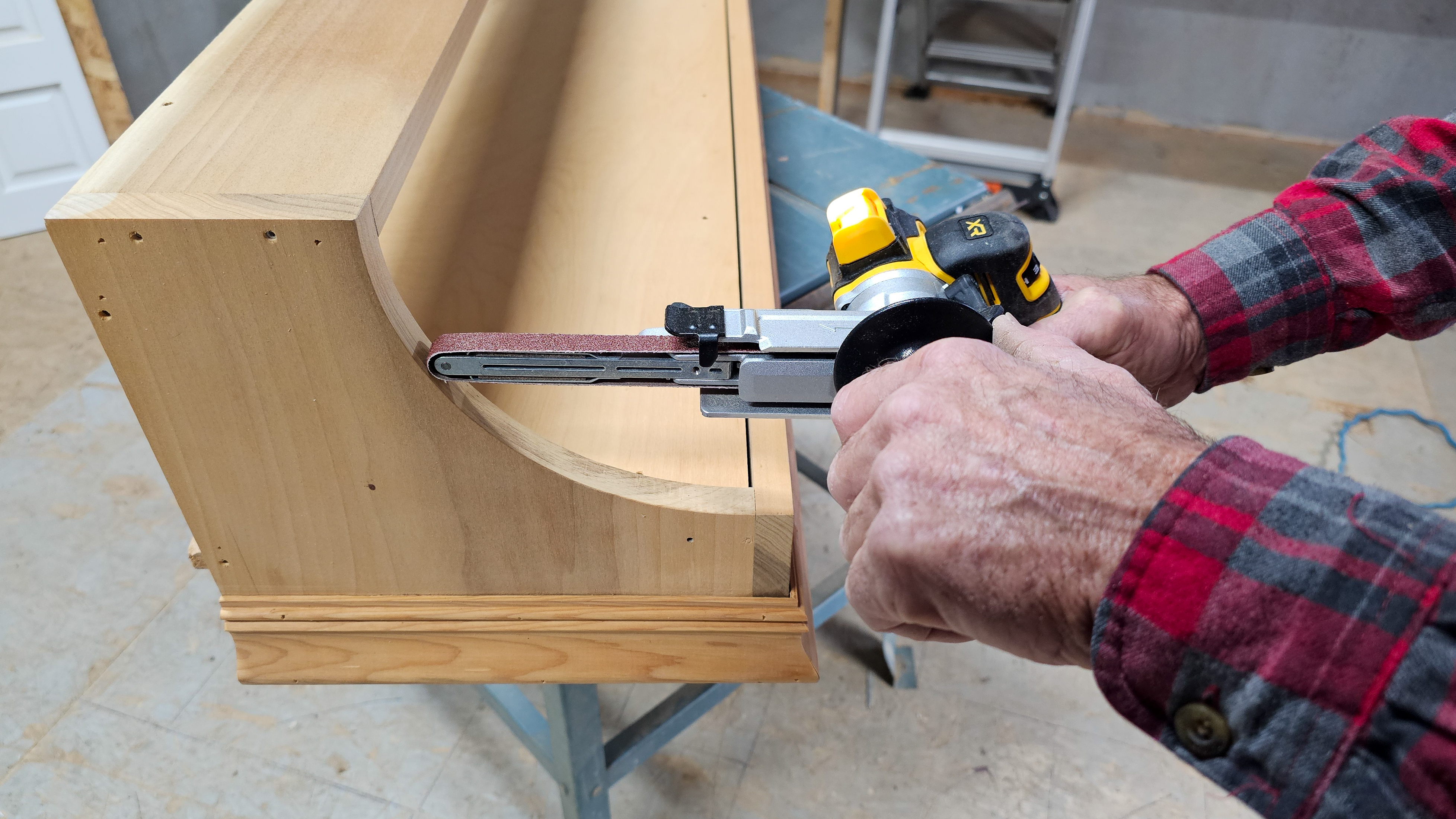
When selecting belt sanders for our lineup, we looked closely at the top brands in the industry, including DeWalt, Makita, Grizzly, and Wen. Initially, we looked for build quality and powerful performance. After we whittled the list down to about a dozen options, we further narrowed it by turning our attention to consumer experience and satisfaction. From that shorter list, we selected the products you see on this list for hands-on testing in our workshops.
The actual testing was straightforward, but the process wasn’t identical for each belt sander. We performed four tests with each sander, but those tests were geared to each sander’s best use. For example, we tested the handheld sanders with large belts for removing old paint and smoothing flat wood surfaces, while we used smaller boards and dowels to test narrow-belt bench-style models and combo machines with sanding discs. Finally, we tested the handheld DeWalt by getting into tight spots and smoothing the wood that would otherwise be difficult to reach.
During testing, we awarded points based on a rubric. The better a sander performed on a test or assessment, the more points it earned. After testing was complete, we averaged the points to determine our best overall pick and to categorize the others as to their best use.
What to Consider When Choosing a Belt Sander
To find a suitable belt sander for your next woodworking project, consider whether you are looking for a benchtop belt sander, a handheld belt sander, or even a completely cordless belt sander for improved maneuverability. Also, research power, speed, size, and weight so that you find the best belt sander for your needs.
Benchtop vs. Handheld
There are two primary belt sander types differentiated by their mobility: benchtop belt sanders and handheld belt sanders.
- Benchtop belt sanders are heavy-duty machines that sit stationary on a sturdy, flat surface during operation. The user needs to bring the material to the sanding belt instead of moving the sander to the material. This makes benchtop belt sanders a great choice for sharpening knives or tools, as a metal belt sander, or for sanding small woodworking projects and more precise work.
- Handheld belt sanders are more portable than benchtop models, though many still rely on a power cord or extension cord for electricity. Shoppers can find a small variety of cordless handheld belt sanders that really let them take advantage of the tool’s portability and mobility. However, these devices are typically less powerful than a benchtop belt sander. Use handheld belt sanders to work on larger projects, like sanding furniture or cabinets.
Motor Power and Power Source
Many belt sanders, including benchtop and handheld models, connect to a power outlet with a power cord or through an extension cord. This corded option offers consistent power, though it limits the range of the device. Some manufacturers also offer cordless belt sander variants that operate on battery power, though these machines are typically less powerful than their corded counterparts. There are also a few pneumatic sanders on the market, but these tools need to be connected to an air compressor, and they are not as reliable as corded belt sanders.
Typically, belt sander motors range from about 2 amps to over 10 amps, though the power output of a cordless sander is usually given in voltage, ranging from 16 to 20 volts. Note that some heavy-duty benchtop belt sanders require a connection to a 220-volt electrical service instead of the standard household 110 volts, so be sure to check the product information before purchase.
Speed
The belt on a belt sander is driven up to high speeds using the rotational force generated by the drums. In most circumstances, the belt speed is measured in feet per minute (FPM), ranging from about 500 to 4,500 FPM or more. Some manufacturers provide the speed in rotations per minute (RPM), so it’s important for buyers to read the details carefully to ensure that they understand the information clearly.
Many belt sanders have just one fixed speed. When users turn the sander on, it will take a few seconds to reach this speed, and it will remain consistent until they turn it off. However, buyers can also find belt sanders with variable speed dials and triggers that allow them to control the speed.
Size and Weight
A small belt sander is a good choice if you need the tool for precise detail sanding, but if you need it to remove thick layers of wood or metal, you will want a heavy-duty product. Look for a tough handheld belt sander for work on larger objects like a table or door. These devices can cause hand fatigue during use, so it’s recommended to find a product with a comfortable grip and ergonomic design to help reduce strain on the user.
Lightweight handheld sanders with broad sanding belts are a good choice if portability is necessary, but if shoppers are in the market for an industrial belt sander, they should opt for a heavy model that won’t shift while they work. Alternatively, most stationary belt sander models can be permanently mounted to a workbench.
Additional Features
Once you have narrowed the selection to a few products using the key factors mentioned above, you can look for additional features, like a built-in dust collection bag, on-off trigger locks, or pressure indicators.
- Dust collection bags help to keep the work site and the project clean while users sand. The built-in vacuum system collects sawdust as it’s created instead of allowing it to sit on the surface of the target material, obscuring the user’s view of the project.
- On-off trigger locks add convenience by eliminating the need to have a finger on the trigger while sanding. Simply pull the trigger, push in the trigger lock, and release the trigger to use the belt sander without needing consistent pressure on the trigger.
- Pressure indicators give the user a visual prompt to indicate when the right amount of pressure is applied or if too much pressure is applied. Typically, this is accomplished with a simple light on the sander that illuminates different colors to indicate the amount of pressure, though it can vary among products and brands.
Tips for Using Belt Sanders
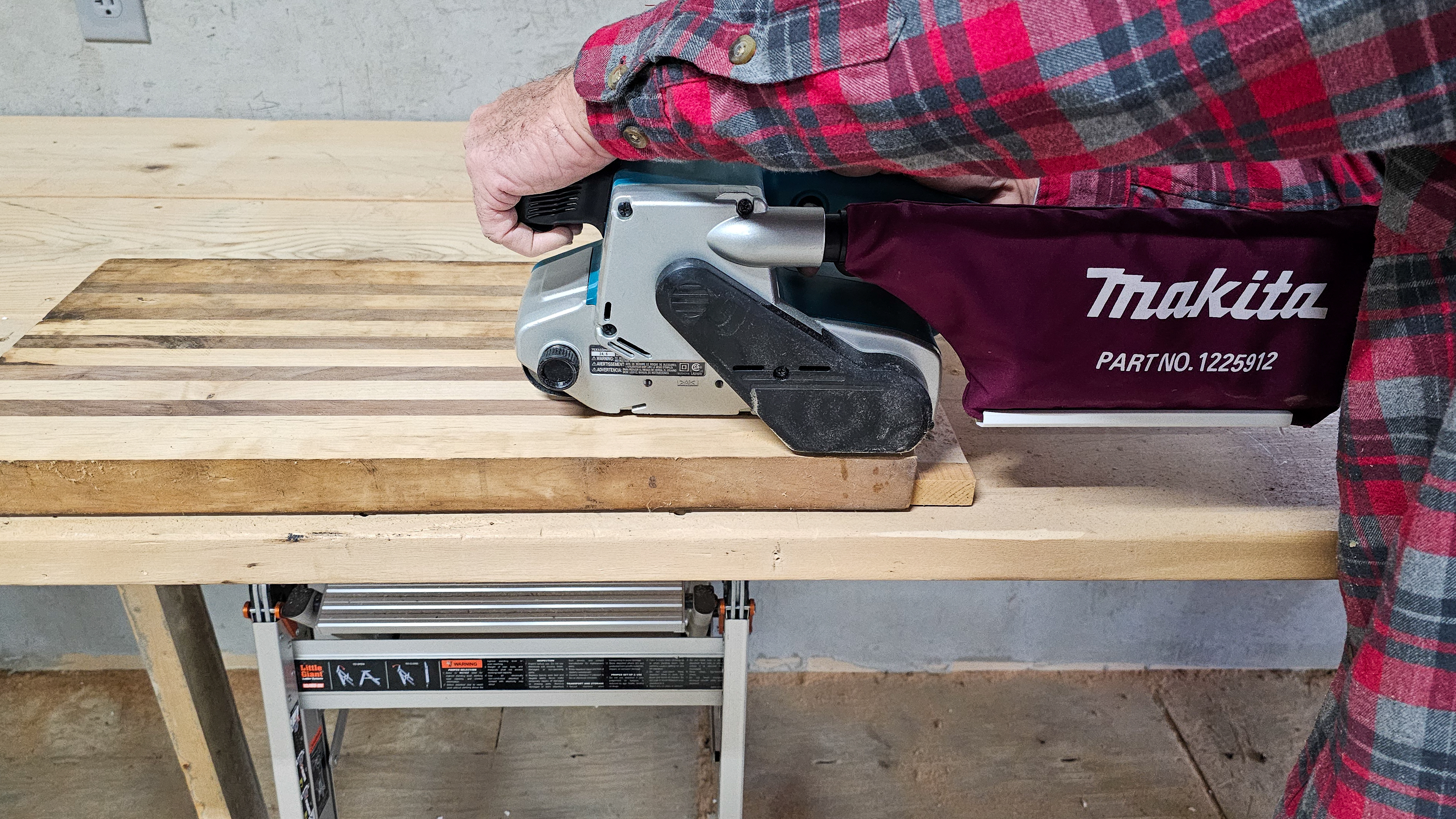
Whenever you use a belt sander, it’s recommended that you wear appropriate personal protective equipment, such as closed-toe shoes, long pants, a long-sleeve shirt, safety glasses, a mask, and gloves. Make sure the space is well-ventilated and that there is enough light to work on the project safely.
Whether you are sanding wood, metal, or any other material, make sure to move the handheld belt sander at a consistent pace to prevent damage to your project. Similarly, if you are using a benchtop sander, you need to move the material at a consistent pace and pressure. Also, ensure the benchtop or table belt sander has a flat, stable surface to sit on during use. This will help reduce vibrations and increase precision.
- Use appropriate personal protective equipment when sanding wood with a belt sander.
- Move the sander at a consistent pace to prevent oversanding or uneven patches.
- Benchtop belt sanders need a flat, sturdy surface to avoid shifting during use.
- If you are using a handheld belt sander, lower the sander to the target material with a slight forward motion.
- Give the sander a few seconds for the sanding belt to get up to the set speed.
- Work the sander with the grain of the wood and avoid leaving the sander or the target material in one place for too long, as this can result in oversanding.
FAQs
If you still aren’t sure how to choose from the best belt sanders, the following answers to some of the most common questions about belt sanders may help you gain a better understanding of how and when to use a belt sander.
A belt sander is a powerful tool used to trim edges, level surfaces, and shape materials. Typically, this tool is intended to remove thick layers of wood and metal to prepare the project for detailed sanding, though some precision belt sanders are suitable for light-duty finishing projects.
The belt on a belt sander lasts about 12 to 18 months, depending on the frequency of use. However, the actual belt sander will last between 5 and 10 years if it is properly maintained, cleaned, and stored when not in use.
No. Let the weight of the sander and the motion of the belt do all the work. Pressing down can result in an uneven surface or gouges.
That depends on the project. A 3-inch by 21-inch belt sander is popular for sanding flat materials, while a model with a narrower belt is better for reaching tight spots or sanding small items.
Yes, but take some time to acquaint yourself with the tool before sanding on the actual project.
Unplug the sander and release the tension lever to remove the old belt. Then, slip a new belt over the rollers and re-engage the tension lever to tighten it in place.
You can, but first, fit the sander with a belt made for sanding metal. A regular sanding belt for wood can wear out quickly when used to sand metal.
Meet the Tester
Glenda Taylor is a contractor, product tester, and writer focusing primarily on construction, DIY tools, and home appliances.
Additional research provided by Timothy Dale.


